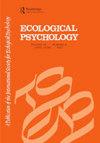Effect of Texture on the Perception of Axis of Rotation of Rotating Panels
IF 1.7
3区 心理学
Q3 PSYCHOLOGY, EXPERIMENTAL
引用次数: 0
Abstract
Abstract Planar, orthogonal structures are very common in man-made environments. We often interact with rectangular structures such as doors and walls in our environment. When a rigid, rectangular structure rotates about a pivot axis, there is information in the ambient optic array, that specifies what the rotating structure affords to the observer. Previous studies identified optical information available to detect the position of the axis of rotation of rotating panels and the current study empirically verifies that observers are sensitive to that information. In one desktop-based experiment and two immersive virtual reality experiments, participants indicated the location of the pivot axis of a rotating panel, as quickly and accurately as possible. Factors like texture on the panel, texture on the background, position of axis of rotation, and linear velocity of the farthest edge from the pivot axis were manipulated. Results indicate that participants were sensitive to texture information associated with invariants specifying the axis of rotation. The results suggest the importance of texture information in vision and how optical invariants help us to directly perceive affordances in built environments.纹理对旋转面板旋转轴感知的影响
摘要平面正交结构在人造环境中非常常见。在我们的环境中,我们经常与门和墙等矩形结构互动。当刚性矩形结构绕枢轴旋转时,环境光学阵列中存在信息,该信息指定旋转结构为观察者提供什么。先前的研究确定了可用于检测旋转面板旋转轴位置的光学信息,而当前的研究从经验上验证了观察者对该信息的敏感性。在一个基于桌面的实验和两个沉浸式虚拟现实实验中,参与者尽可能快速准确地指示旋转面板的枢轴位置。操纵了面板上的纹理、背景上的纹理,旋转轴的位置以及离枢轴最远边的线速度等因素。结果表明,参与者对与指定旋转轴的不变量相关的纹理信息很敏感。结果表明,纹理信息在视觉中的重要性,以及光学不变量如何帮助我们直接感知建筑环境中的可供性。
本文章由计算机程序翻译,如有差异,请以英文原文为准。
求助全文
约1分钟内获得全文
求助全文
来源期刊

Ecological Psychology
PSYCHOLOGY, EXPERIMENTAL-
CiteScore
3.30
自引率
10.50%
发文量
8
期刊介绍:
This unique journal publishes original articles that contribute to the understanding of psychological and behavioral processes as they occur within the ecological constraints of animal-environment systems. It focuses on problems of perception, action, cognition, communication, learning, development, and evolution in all species, to the extent that those problems derive from a consideration of whole animal-environment systems, rather than animals or their environments in isolation from each other. Significant contributions may come from such diverse fields as human experimental psychology, developmental/social psychology, animal behavior, human factors, fine arts, communication, computer science, philosophy, physical education and therapy, speech and hearing, and vision research.
 求助内容:
求助内容: 应助结果提醒方式:
应助结果提醒方式:


